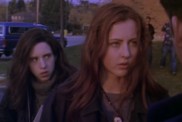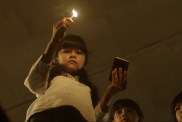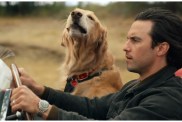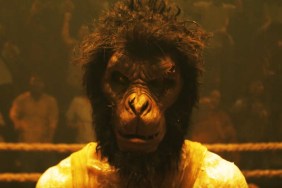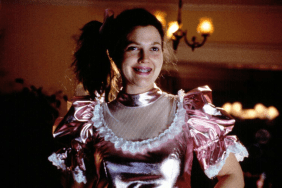To go too into depth in trying to explain the plot for Upstream Color, the new movie from Primer‘s Shane Carruth, would probably be doing it a disservice, since everyone who sees the movie will probably get something different out of what’s happening (or not happening) in some of the more esoteric moments.
At its core, the movie is a love story between two people who meet on a train, played by Carruth and Amy Seimetz, and as their relationship grows, they start to bond and learn more about each other and a traumatic shared experience they underwent. That’s the long and short of a film that involves orchids, tapeworms, pigs and even freakier things that will inspire a lot of discussion about what Carruth was trying to say with the film.
Anyone who has seen Carruth’s Sundance prize-winning 2004 time travel film Primer can guess that he is an incredibly intelligent and introspective filmmaker and when ComingSoon.net sat down with him a few weeks, we learned a lot of surprising things about the making of the film without ever outright asking the question on the minds of those seeing the movie, which is, “What is this movie about?”
ComingSoon.net: This has already been a good year with a new David Bowie record and now a new movie from you.
Shane Carruth: (being facetious) Those are comparable to each other, that makes perfect sense.
CS: I recently spoke with Derek Cianfrance and he took 12 years between his first movie at Sundance and his second movie, so nine years isn’t that long. Was this something you’ve been developing for a long time? At what point did you say, “Okay, I’m going to start working on this movie?”
Carruth: No, I wasted a bunch of time trying to get this other thing made and I couldn’t raise the money for it, but I invested a lot of time and energy in getting the story and the design of it perfected. But no, for “Upstream,” it was probably about a year of collecting some of the rough story elements. It was more of a thought experiment, the idea of personal identity and personal narrative, and when that stuff gets cemented and whether that dictates behavior or whether behavior dictates that or it’s the other way around. That’s where it started, and it got bigger and bigger and bigger because I was playing with the idea
“Well, what if I stripped this away from some people and they have to rebuild this? They have to wake up in a moment and atone for what it looks like they must have done and come to some conclusion about what that means about them, what kind of person they must be, and then they try to follow through on that.” That was sort of the thought experiment, but the bigger and bigger it got, the more it was not just political beliefs or religious beliefs, but everything that a person can be, the collection of all of their experience and then the way that they viewed the world and the way the world views them, or the way that they imagine that to be and ethics and morality, all of that stuff getting stripped away. The bigger and bigger that got, the more and more emotional it felt to be just stripping somebody of this. That led to the idea of this sort of romantic promise that exists when two people are just broken to their core. So I think that was about the point that I couldn’t see anything else but this story and I just had to follow through on it.
CS: Was this “A Topiary”?
Carruth: The project I wasted time on was “A Topiary.”
CS: Got it. I wasn’t sure because I’m sure you realize that most people first heard you were working on something from Rian Johnson’s tweet about a new project, but you spent time on that and then went onto this instead.
Carruth: Yes.
CS: How hard was it to get financing for this one? I remember “Primer” was famously made for just $7,000. This one seems like a much bigger budget, so was it harder to sell this idea and try to explain what you wanted to do with it?
Carruth: No, I never had to do that, no. This is money from a couple of friends and myself and no formal film financing, no formal pitching. There’s just, “We are going to go make this story,” and they were just completely supportive. So we don’t have those kind of conversations. There aren’t notes being passed or anything like that.
CS: That’s really the way to make movies, if you can do that
Carruth: It’s the only way. It’s absolutely the only way, I mean, for me, absolutely.
CS: Let’s talk about Amy because obviously she’s a major part of the movie, and she’s a filmmaker herself, I understand.
Carruth: Yeah.

CS: How did you get her involved?
Carruth: David Lowery and Toby Halbrooks, who I’d met a few weeks before we’d started shooting, they gave me her name as just a potential actress, and really I was looking at a lot of different actresses because obviously the role’s very important. I mean, she’s the whole thing. She was in Florida editing “Sun Don’t Shine,” her latest film that she wrote and directed, and I called her up and she said she was editing and I just blew that off completely. I don’t know what that means. Actresses do not edit, so what we’re talking about is something else, but I felt like we connected in some way and had some sort of a shorthand. Then, she sent me her film and I saw about 10 minutes of it and I think I hadn’t even seen her act, maybe a minute or two on some YouTube clip, but I had definitely never seen any film that she’s been in other than “Upstream,” but the film that she wrote and directed was so strong. I mean, 10 minutes in, I just felt like this is a person that gets narrative. This is going to give us a shorthand and a way to communicate that’s going to remove 95 percent of our conversations because she’s just going to get it with the thinking. Then I asked her to be involved, and she did, and then I don’t know. She’s really wonderful. I mean, she looks perfectly appropriate to this role. She’s so malleable. She can play every ribbon of the narrative. She can be fractured and fragile and tough and everything that she needs to be. So I just lucked out.
CS: Yeah, she was great. How scripted was the movie? It’s a very visual film and it’s very visually driven, but it’s also relationship and character-driven as well with a very deliberate way of delivering dialogue. How much was it scripted as far as describing the visuals and what you wanted to do as far as that side of it?
Carruth: Yeah, I mean, it’s surprisingly very, very close to the script. There are parts that are meant to feel subjective and ethereal, but there’s not a lot of made-up stuff. What did happen is I would say that the first third of it is just rigidly scripted. It’s just exactly like the script. The second third of it, I think of that as the (part where) we are watching Kris and Jeff react to something that we know they have been through, but they don’t know, and it becomes an extremely subjective and more emotional experience. The cinematic look changes there and it almost becomes like found footage for a moment, and then it’s very verité and it’s just whatever it needs to be moment by moment. Because of that, I felt like we had reached a point where we had so well-internalized what this story is meant to do that we did have the freedom to go and play just a bit and be lyrical. We have the shared memories sequence, and that I think is probably the bit that seems the most improvised and made up, but in reality, it was scripted. It was just so well-internalized that we could jut out to different places and just try to have something authentic because that’s the only thing that mattered in that. It wasn’t who says what when, it was during each of these moments, are they authentic and do we have escalating tension? Like, we need to play one scene this way and we need to play another one with more tension. One’s playful, one’s angry, so in that sense, that would’ve probably been something that would’ve been futile to script that way because it would’ve been too mechanical and the end result would’ve been the same.
CS: How did you get to a level of comfort between the two of you as actors to get to the point where you could have the script so well internalized? How far in advanced before shooting did you actually meet Amy?
Carruth: I didn’t meet her in person until she landed in Dallas. I picked her up at the airport, took her to my brother’s house where my nephews were. I took pictures of her holding my nephews because we needed those prop pictures in the film, especially with her with long hair because she showed up in the apartment with long hair, then a couple of hours later, we were shooting the first scene.
CS: Really, you meet and then you just start shooting?
Carruth: Absolutely. Yeah, I remember the first thing we shot was her in the grocery store when she finds out her credit card isn’t working. She has that brief little thing. That was the first thing we shot. Yeah, we just hit the ground running. I guess that’s the thing is that I just feel like there was never a moment that she wasn’t
okay, that’s not true. I was going to say there was never a moment that she didn’t know exactly what we were doing, but I mean, that’s not true for anybody, but it was innate, seemingly. It was just not a lot of conversation.

CS: It seems very ambitious compared to “Primer” because there are a lot of locations. You have the supermarket, you have the train, you have the pig farm, as well as a lot more things going on. Was it a fairly long shoot to get all that you needed?
Carruth: We did not do a good job of scheduling this film. You know, it’s weird. Everything I end up doing ends up being made up because I reject the way it’s been done, but I don’t necessarily have a better solution, so it’s like, I hate the idea of keeping people to four in the morning and making them work 15 hour days just because of some rigid 18-day shooting schedule or whatever it is. I thought that’s a recipe to not do the best work, so let’s take our time and make sure that we’re treating people well and that we all have time to sort of think about what we’re doing. But then, I think we went too far the other way and it was like, “This is dragging on forever.” You know, and I don’t know. We were just hacking stuff together.
CS: Everything in the movie seems so precise and specific that you could’ve spent hours crafting each shot to be exactly right.
Carruth: Well, no, that more or less is the case, and that’s the thing. I would shoot too slow because of that, because it needed to be a certain way. It’s like I don’t know the answer. I don’t know if what we did was wrong or whether that was right and we just needed more resources to be able to have that luxury, because after a while it really starts to be taxing. Yeah, I don’t know.
CS: How different was this than making “Primer” then, because that was your first film where you were kind of doing everything for the first time for the most part, and for the second one, you have more experience and more general knowledge?
Carruth: It’s weird. I mean, it both feels the same and it feels much different. I don’t know. I feel like everything that I swore I would never do after “Primer,” we ended up doing again on this. At the same time I know that this is a much better film. I mean, I know that more than I know anything. I know that it’s a good work, and I’m very grateful for the way “Primer” was received, but I see many, many flaws in it, and “Upstream” may have some flaws, but nothing that compares to its strengths. I’m just really proud of it. I think it’s a well thought out, well executed work.
CS: No, I agree. “Primer” was really cool and interesting and well written, but this is something above and beyond what that was. There have been many comparisons between this movie and those of Terrence Malick and I wondered if you think that’s a fair comparison? I didn’t read a lot about the movie after Sundance, but that was the one comparison I saw more than anything else.
Carruth: They seem to be using his name for almost
I mean, even David Lowery’s movie (“Ain’t Them Bodies Saints”), they say it’s Malick-esque or Malicky or whatever the word is.
CS: So you think they throw Malick’s name around like they do Hitchcock?
Carruth: That’s what it seems like.
CS: It’s just an easy way to describe something.
Carruth: Yeah, it’s like if something is at all interested in cinematography and lyricism, then great, let’s call it “Malick,” which I’m not going to be insulted by that. He’s one of my favorite directors, obviously. I don’t think anybody actually thinks that I’m anything like Malick, but I think it’s an easy thing for people to say.
CS: Going back to the visuals, it seems that a lot of stuff in the movie like the underwater sequences and inside body would need to be done with visual effects. Is that the case?
Carruth: It’s all practical, there’s no computer generated anything in this at all, not even the end credits.
CS: Really? That’s amazing. So how do you go about doing stuff like that? You have cameras that go inside the body so did you have people you knew who could do stuff like that?
Carruth: I mean, I started shooting some stuff while I was writing, some of the microscopic stuff, the little blue spheres that would balloon up. I started doing a lot of time lapse while I was writing. I mean, I did hours and hours and hours worth of this stuff just to see if I could get it because I had an idea of what I needed it to look like. I would do that and do that and do that until I could get it. Then, we started to just develop the here’s what this world looks like. Here’s where you go in, here’s what it looks like. It’s Tom Walker, the production designer, was able to put together all sorts of wonderful things. It wound up being a back room in a house that I was renting in Dallas, and we had everything in there from chicken breasts and red dye and ground beef and we tried lots of things with the worms, bits of rope or nylon tied in knots and pulled through latex before eventually giving up and saying, “Let’s just go to the store and buy some night crawlers and do this.” Yeah, it was just a ton, a ton, a ton of trial and error. NobodyTom, not me not anybody had really any experience with how to do this, except for the bits where we can see the worm crawling under Amy’s skin. That was actually someone who’s a makeup artist and he had some experience with how to do stuff like that, yeah.

CS: All practical, that’s amazing. I remember when Darren Aronofsky was making “The Fountain” and they did all the outer space stuff without using computerized visual effects, and it actually gives the movie a very different look. Did you do a lot of storyboarding as well to figure out what this should look like?
Carruth: You mean just with practical photography? No, I mean, so much of the
especially the last third of this, we had so much that’s being communicated through match cuts that the composition was so important. So on my phone, I would have a still from the scene we shot yesterday, and I know that, “Okay, with my camera today, we’ve gotta line up our characters in the frame exactly after they were in the other location.” So there was a lot of that, I mean, constantly matching lenses, matching distances, just making sure that every match cut worked.
CS: I also wanted to ask about the passage of time from when Kris and Jeff first meet. The passage of time isn’t very clear in terms of how much time has passed since she discovered what happened. They don’t know how much time has passed in their relationship. Is that something you were very conscious of while editing it together? As you watch the movie, it could be weeks, it could be months, it could even be years.
Carruth: Yeah, that’s one of the many things where it’s here’s what’s important and everything else can just melt away. In the cinematography, it works the same way. Most of the time we are on somebody’s face or we’re on their hand and the rest of the world is a blur of color and abstract shape, for the most part. That’s because so much of the story is about characters that feel affected by something just off screen, just out of reach, not even quite clear what direction to point at, at where the thing might be. It’s so much about isolation and subjectivity, so that dictated that. I’m so sorry. I’m losing track here. What was the original bit you were talking about?
CS: The passage of time.
Carruth: Well, yeah, I mean, there was definitely a purposeful way to change, like the way she dresses at the beginning and with her long hair is distinctly different than the way she is once she’s been damaged. Then that’s distinctly different than the way she is once we get into the mode that we call the domestic bliss, where they move into the suburbs and that would hopefully be the end of the movie. That should be the end of the movie, but it can’t be because still, nothing’s resolved for them. I always meant for to
even if we don’t say six months later, one year later, that something about it needs to change in order to reflect that.
CS: I loved the music, too.
Carruth: Oh great.
CS: Was that in your head while you were writing it, a lot of the music that would go with it? Was that a hand in hand kind of thing?
Carruth: Yeah, by the time I was writing the script I pretty much had a complete score or the way I thought of the score for the film. I ended up throwing out about half of it because I’d made a mistake and I’d written some music that it was trying to guide the audience as to what they’re meant to be thinking or feeling, but it was not in unison with the characters’ subjective experience. So, once I realized that, once I realized where visual language is doing that, I think, in a good way, but our music isn’t, our music’s fighting that, and so I threw out half of it and rewrote the bits that I needed.
CS: I stayed to the end of the credits because I really wanted to know who did the music. Did you do the music on “Primer,” too?
Carruth: Yeah.
CS: I’m not sure I remembered or realized that because I was really so blown away by the music in this and the whole time was thinking, “Who did the music? Is it Alexandre Desplat or one of those guys?”
Carruth: Oh man, that’s very flattering.

CS: Yeah, it really worked. Now, even before Sundance, you already decided to self-distribute the movie. At what point did you decide that was the way you wanted to get it out there rather than looking for distribution at Sundance?
Carruth: Yeah, I was living in Dallas for a long time and I made the decision that I was going to be moving when the film is done. So the film is done and I came here (to New York) and started to think about, “Great. What’s the landscape look like for this film?” I was hopeful for Sundance, and everybody has their plan A. They go to a festival and they hope for acquisition, and then we all ride into the sunset, but everybody also thinks of plan B, like “What if that doesn’t happen?” That’s what I was working on. It was like, “Okay, great. What’s plan B?” I’ve already been through distribution once with a distributor. “What does it look like if I was to hire all of the elements they hireda theater booker, national and regional PR, key art,” all of the logistics of that? I basically spent time here and in LA sort of just having tons and tons and tons of conversations about what that looks like, what it costs and whether it’s possible. I mean, I was basically walking into offices and saying, “This is going to happen. Let’s talk about how it’s going to happen.” It was just really naïve, but before long it seemed possible, and that I could basically build at least the same distribution that “Primer” got for a fraction of the cost. The most important thing is that I would get to decide everything about it. I would be able to craft the marketing to what I think is appropriate to the film. I can manage expectations. I can contextualize, which I began to see more and more as a continuation of storytelling. I mean, it’s picking the cover of the book and the font and the texture of the paper for a novel. That’s the way I wanted to think about it. I don’t want a distributor deciding that the most compelling bits of this story are the weird bits, and so let’s put those on the poster. We have one that’s hopefully a very compelling image, but it speaks to more about what the film’s about than trying to get every last dollar. So I don’t know. That idea, now thinking back, I can’t believe I ever entertained the idea of not doing that, but yeah, that’s where it came from. Then it’s just been a long eight to nine months of putting it all together.
CS: It’s really interesting because I talk to a lot of filmmakers and it’s surprising how few of them want to be involved in marketing. They want to put it on someone else, which is interesting because like you say, getting the movie out there to an audience and saying what you want to say, the marketing basically is what does that. You can do as many interviews as you want, but it’s usually the trailer or the poster that tends to determine whether anyone sees your movie or not.
Carruth: That’s exactly how I feel. I’ve gotten really comfortable with that because it just seems like we’re filmmakers, we’re storytellers, we do 95 percent of the job, and then at the last second we hand it over to a distributor to decide what the film’s about and to communicate it to people? I mean, I know nobody wants to take it on. This is a big challenge–nobody wants to be doing this if they could be making another film. But if there’s a way to make it a continuation of the story, then I would like to see that happen.
CS: So where do you go from here? I mean, obviously you’re going to have a little while getting this movie out there over the next month or so. Do you have another script you want to start shooting?
Carruth: I do. I’m finishing it right now. It’s called “The Modern Ocean.” It’s amazing. I cannot wait to get on it because right now I’m so fortunate to be doing this distribution, but if I had my way, I would be writing 12 hours a day. I can’t wait to get to it. I hope to be shooting by end of summer.
CS: Will you take the same approach in terms of financing?
Carruth: Yeah, with a few caveats. I mean, it’s going to need some money. What we did with “Upstream” is not repeatable, so it’s going to be a mix of, hopefully the money that this film makes, every dollar it makes goes into the next one. But we’re also going to have to solve something else. I’m going to have to figure out how to raise money without somebody thinking that they’re going to give me notes, so that’s my next challenge.
CS: You should wait outside “Upstream Color” and watch people exit. If they look rich and they look happy then they can be prospective financiers
Carruth: Yeah. (Laughs)
CS: What’s your take on VOD? It doesn’t replicate the theatrical experience.
Carruth: Oh, you know what’s weird? As an audience member, I don’t really have a strong opinion about that. I mean, like “The Master,” it was really important to me to go see that in the theater, but that’s a very rare occurrence for me. I typically enjoy things on my laptop. I’m in bed, I can be able to pause them. Yeah, anything that you get from seeing a big screen seems to be negated by the experience of having to go to someplace and
CS: Be with other people.
Carruth: Yeah, and just be subjected to the Coca-Cola commercials. I mean, it’s a funhouse, where sometimes I would like it to be a museum instead. So yeah, I don’t know. I don’t feel strongly about it. Wherever people want to meet the narrative is fine with me.
Upstream Color will open in New York City at the IFC Center on Friday, April 5 and then in other cities on April 12 and beyond. You can see when it’s playing at a city near you on the official site.
